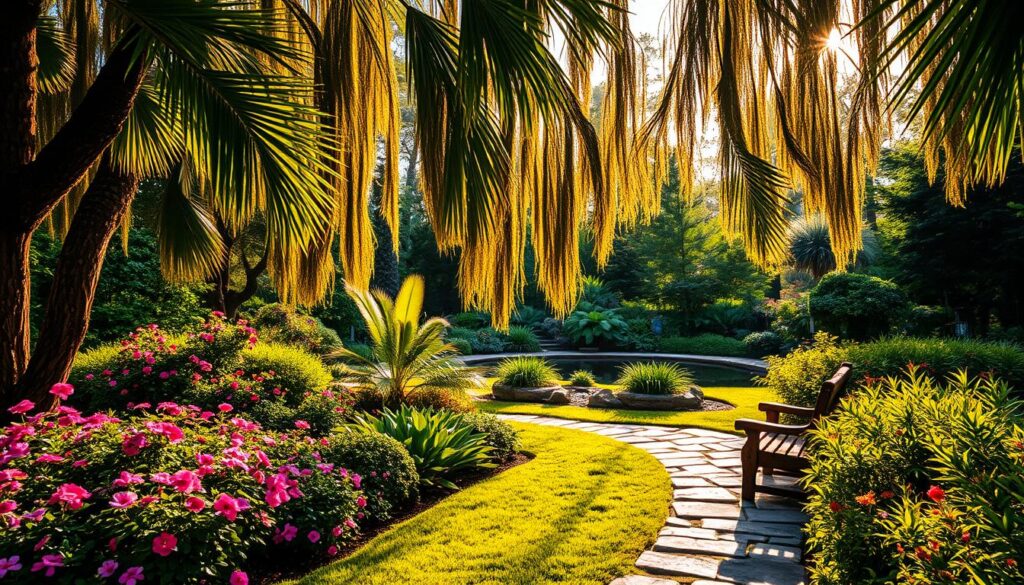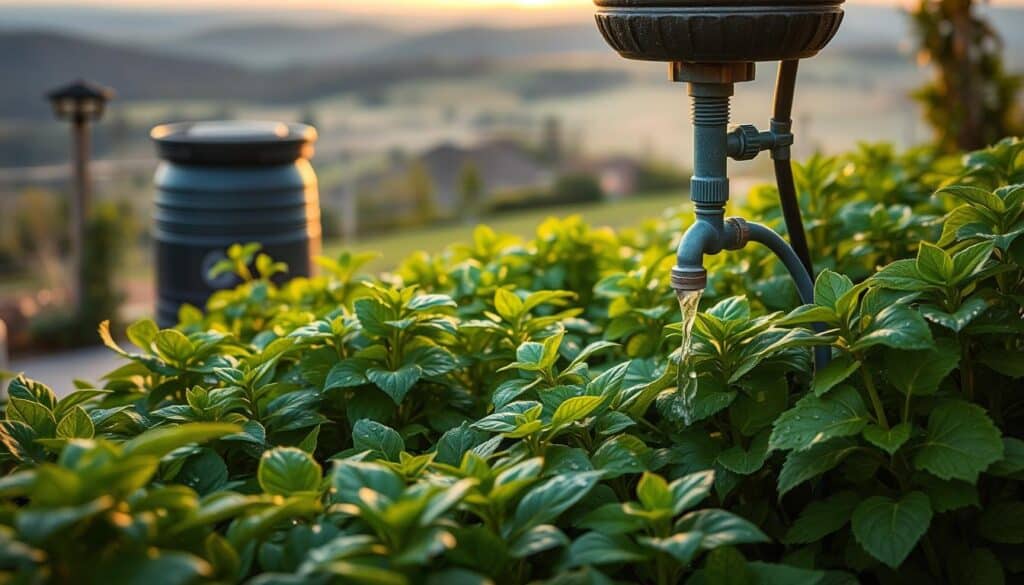Gardening Tips: Cultivate Your Green Oasis

About the Game
Gardening is more than taking care of plants; it’s about creating a space that reflects who you are. It turns your outdoor area into a beautiful, peaceful escape. This guide is full of advice for everyone, whether you have a big yard or a small balcony.
Learn to make your own special green oasis. Understand the many environmental advantages gardening offers.
Importance of Gardening
Gardening brings many benefits to our health and the planet. It gets you moving, which is great for staying fit. Gardening also eases stress, making it easier to relax and find peace. Working with plants improves your mood and helps you be more mindful.
Anúncios
Gardens are good for the environment too. They create homes for many creatures and improve the air we breathe. They also cool down the area in cities, making it nicer to be outside. Every garden is a tiny nature save, promoting a green and healthy world.
Planning Your Garden
Planning your garden well is crucial for making a space that’s both beautiful and useful. First, look at the space you have and think about things like how much sun it gets and what you like. It’s important to plan your garden carefully to make sure everything looks and works together nicely.
Anúncios
Begin by making a simple plan that shows where flowers, bushes, and areas for growing veggies or herbs will go. Put plants in order based on their height, colors, and when they bloom. This makes your garden look good all year.
Adding features like paths and places to sit can really improve your garden. Paths make it easy to walk around, and seating areas are perfect for relaxing and enjoying the view.
Choosing the Right Plants
Choosing the right plants for your garden is key to a lush, inviting area. Start by looking at what plants work well in your local weather. Going for native plants is smart because they grow well with less work.
Adding different kinds of plants makes your garden look better and helps local animals. Plants like coneflowers and milkweed bring in important bugs like bees and butterflies. This helps keep nature in balance.
- Assessing soil type and drainage capabilities
- Identifying sunlight levels in different areas of your garden
- Choosing plants based on seasonal interest and growth patterns
Putting together flowers, green plants, and food plants makes your garden diverse. It’s both pretty and useful. Picking plants this way helps your garden thrive.
Soil Health and Fertilization
Healthy soil is key to a great garden. Testing your soil lets you know about its pH and nutrients. This helps gardeners improve the soil, making plants grow better.
Using fertilizer regularly is important for soil health. Options like compost and natural fertilizers make plants grow strong and flowers bloom. They help the soil feel better and feed the plants, making your garden a lively place.
Knowing what your soil is made of helps you pick the right plants. It also guides your gardening methods. This doesn’t just help plants grow; it makes the whole garden’s nature thrive.
Nurturing Your Garden
Every garden thrives with regular care, including the right amount of water for each plant. You might need to change your watering habits, depending on what you’re growing. This way, each plant gets just what it needs to grow strong and healthy.
It’s crucial to watch out for pests and diseases. Catching them early can stop bigger problems later. Using good pest control like helpful bugs or natural treatments helps keep your garden safe and sound.
Pruning and removing dead flowers helps more blooms grow. Checking your plants often keeps your garden looking its best. Each time you care for your garden, you learn a bit more about how plants grow.
Gardening Techniques for Beginners
Starting simple helps newcomers see quick wins. Tips for new gardeners focus on picking plants that are easy to care for. They must learn about watering, sunlight needs, and sticking to a care plan. These steps build a strong foundation for more gardening later on.
Starting with pots is great for those new to gardening. It lets them handle a small section without feeling swamped. Trying out pot gardening can give instant joy and build up confidence.
Learning resources are crucial for beginner gardeners. Gardening clubs offer support and advice from the community. Websites and online classes give tips from experts, helping those new to gardening get better.
Creating a Sustainable Garden
Sustainable gardening helps our environment. Using organic methods like composting and avoiding chemicals improves soil health. It helps create a garden where plants and wildlife flourish together.
Conserving water through methods like drip irrigation saves important resources. Adding native plants to your garden helps local wildlife. These plants need less fertilizer and pesticides, making your garden more natural and alive.
- Implement organic pest control measures.
- Engage in composting to enrich soil.
- Utilize water-saving techniques like drip irrigation.
- Plant native species to enhance biodiversity.
By choosing these green practices, gardeners make a difference. They help our planet and enjoy the beauty of their work.
Water Conservation Strategies
Effective water conservation is key for gardens that last. By saving water, gardeners keep their greens happy with less. Collecting rainwater is a smart move, it means using less tap water. This method uses gutters to catch rain, which gets stored for the garden. Then, it’s easy to use this water with a drip system.

Drip irrigation is a top choice for saving water. It sends water right to where plants need it most. This cuts water use in half, making gardens more efficient. It also helps keep the soil in good shape by keeping moisture levels steady.
Choosing the right plants saves a lot of water, too. Drought-resistant plants need fewer waterings. They’re tough and help local wildlife by offering them a home.
Mulch is a garden’s best friend for holding onto water. It keeps the soil moist and stops weeds. Plus, it feeds the soil as it breaks down. Mulching means less watering and happier plants.
Using these smart watering methods and picking the right plants help the planet. They fight climate change and keep our air and water clean. This way, gardens do more than look pretty; they help Earth.
Urban Gardening Solutions
Urban gardening turns city spaces into green spots. You can garden in containers, making it easy to grow plants on small balconies. This means fresh veggies, herbs, and flowers right at your home, no matter the space.
Vertical gardening lets you use walls for planting. It involves hanging planters or stacking pots up high. This way, you get more plant space without using the floor. Plus, it makes city places look nicer.
Community gardens are about people working together. They grow food and beauty in shared spaces. These gardens are great for making friends and learning new things from neighbors.
Urban gardening makes cities greener and life better. By trying container and vertical gardening, people can grow their own food. This also helps everyone feel closer to nature and improves their area.
Indoor Plants for Green Spaces
Indoor gardening adds a fresh feeling and brings health benefits. It makes air cleaner by removing toxins, using houseplants. It’s important to pick the right ones, like snake plants, peace lilies, and pothos. They help clean the air and make the place look good.
For successful indoor gardening, think about these things:
- Evaluate lighting conditions in your home.
- Consider humidity levels, which affect plant growth.
- Choose low-maintenance houseplants for easier care.
Adding plants inside can make you feel better. They make places look nice and help us relax. Bring these green buddies into your house for a healthier, welcoming space.
Benefits of Incorporating Wildlife Into Your Garden
Adding wildlife to your garden boosts its ecological balance. It invites animals, from birds to helpful bugs, making your garden healthier. Using native plants attracts important pollinators like bees and butterflies. These help plants make seeds and grow.
Pollinators boost the environment’s diversity, benefiting everything living in it.
To bring wildlife in, make your garden appealing to different animals. Some tips include:
- Install birdhouses to provide shelter and nesting opportunities.
- Create small water sources, such as birdbaths or ponds.
- Maintain wildflower patches that serve as a food source for pollinators.
These steps create a lively garden, helping it and local biodiversity. By welcoming wildlife, you build a garden that lives in harmony with nature.
Conclusion
Starting your gardening path is rewarding. It makes your space beautiful and helps the environment. Using sustainable ways, you can grow a colorful garden. This garden will help different living things and keep the environment healthy.
It’s important to pick the right plants and mix them up. This ensures your garden does well and feeds good insects and animals.
Gardening is more than a hobby. It’s a step towards a healthier life and connecting with others. Caring for your garden links you to nature. It brings joy and peace.
Working together in community gardens shows the strength of teamwork. It joins people in a common goal of health and support.
Every plant you look after shows you care about our planet. Let your garden grow and see the difference it makes. Gardening is for everyone. Whether you’ve been doing it for years or just starting. Your love for plants helps us all aim for a better, green world.
FAQ
What are the basic steps to start a garden?
How can I choose plants that thrive in my climate?
What are effective methods for ensuring healthy soil?
How often should I water my garden?
What sustainable practices can I incorporate into my gardening?
How can I make the most of limited space for gardening?
What are the benefits of indoor gardening?
Why is it important to incorporate wildlife into my garden?
Game Details
No
No